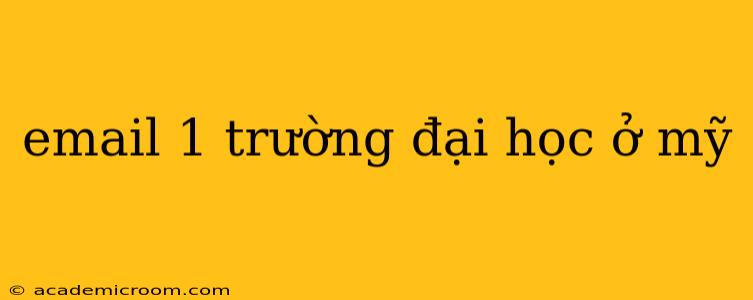How to Email a US University: A Comprehensive Guide
Applying to a US university is a significant step, and crafting a compelling email is crucial. This guide will walk you through writing effective emails to university departments, professors, and admissions offices. We'll cover everything from addressing the recipient correctly to tailoring your message for maximum impact.
What type of email are you writing?
This significantly impacts your approach. Are you:
- Inquiring about admissions? This requires a formal tone and focuses on your academic achievements and aspirations.
- Contacting a professor for research opportunities? This needs to highlight your relevant skills and research interests.
- Seeking information about a specific program or department? This focuses on your specific questions and requires clear, concise communication.
Let's examine each scenario individually.
1. Emailing the Admissions Office:
Subject Line: Keep it concise and informative. Examples: "Application Inquiry - [Your Name]", "International Application Inquiry - [Your Name]", "[Program Name] Application Question"
Body:
- Formal Salutation: Begin with "Dear [Admissions Officer Name]," if you know it. If not, use "Dear Admissions Committee," or "Dear Admissions Office."
- Introduce Yourself: Briefly state your name and intended program of study.
- State Your Purpose: Clearly explain why you're emailing. Are you inquiring about application deadlines, requirements, or the admissions process itself?
- Ask Specific Questions: Avoid vague inquiries. Formulate clear, concise questions.
- Highlight Relevant Qualifications (briefly): If appropriate, subtly mention key achievements relevant to your application.
- Professional Closing: Use a formal closing such as "Sincerely," or "Respectfully," followed by your name and contact information.
2. Emailing a Professor:
Subject Line: Be specific and highlight your research interests. Example: "Undergraduate Research Inquiry - [Your Name] - [Research Area]", "PhD Application Inquiry - [Your Name] - [Professor's Research Area]"
Body:
- Formal Salutation: "Dear Professor [Professor's Last Name],"
- Introduce Yourself: Briefly state your name, your current academic standing (e.g., undergraduate student at [University]), and your field of study.
- Express Interest in their Research: Show that you've researched their work. Mention specific publications or projects that resonate with you.
- State Your Purpose: Clearly state your reason for contacting them. Are you seeking research opportunities, mentorship, or simply seeking clarification on their work?
- Highlight Relevant Skills and Experience: Mention relevant coursework, research projects, or skills that align with their work.
- Attach your CV/Resume: This provides a concise overview of your qualifications.
- Professional Closing: Use a formal closing like "Sincerely," or "Respectfully," followed by your name and contact information.
3. Emailing a Department:
Subject Line: Be clear and concise. Examples: "Inquiry about the [Program Name] Program," "Information Request - [Your Name] - [Program Name]"
Body:
- Formal Salutation: "Dear [Department Name] Team," or "To Whom It May Concern,"
- Introduce Yourself: Briefly state your name and the reason for contacting the department.
- State Your Purpose: Clearly explain what information you need. Are you seeking details about specific courses, program requirements, or faculty expertise?
- Ask Specific Questions: Avoid vague inquiries. Formulate clear, concise questions.
- Professional Closing: Use a formal closing such as "Sincerely," or "Respectfully," followed by your name and contact information.
General Tips for All Emails:
- Proofread Carefully: Errors in grammar and spelling can create a negative impression.
- Use a Professional Email Address: Avoid using informal email addresses.
- Keep it Concise: Get to the point quickly and efficiently.
- Maintain a Formal Tone: Use professional language and avoid slang.
- Follow Up: If you haven't received a response within a week or two, it's acceptable to send a polite follow-up email.
By following these guidelines, you can significantly increase your chances of receiving a positive and informative response from US universities. Remember to tailor your email to the specific context and recipient for optimal results.
